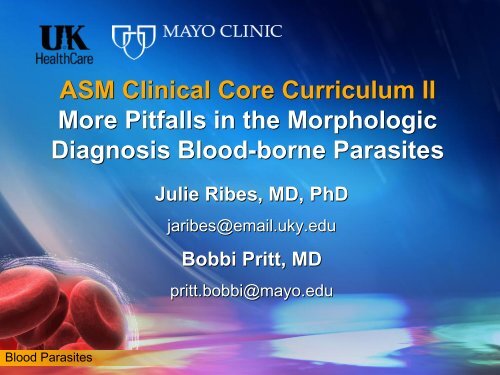P. falciparum
P. falciparum
P. falciparum
You also want an ePaper? Increase the reach of your titles
YUMPU automatically turns print PDFs into web optimized ePapers that Google loves.
Blood Parasites<br />
ASM Clinical Core Curriculum II<br />
More Pitfalls in the Morphologic<br />
Diagnosis Blood-borne Parasites<br />
Julie Ribes, MD, PhD<br />
jaribes@email.uky.edu<br />
Bobbi Pritt, MD<br />
pritt.bobbi@mayo.edu
Objectives<br />
Upon completion of this session, participants<br />
should be able to:<br />
Describe common pitfalls in the morphologic<br />
diagnosis of malaria and other infectious agents<br />
in blood films<br />
Blood Parasites
Disclosures:<br />
None<br />
Blood Parasites
Demonstration and Identification of Blood<br />
Parasites - General<br />
Giemsa-stained thick and thin blood films are the gold<br />
standard for diagnosis of malaria and other blood<br />
parasites<br />
Other methods:<br />
Blood Parasites<br />
Antigen detection, PCR, serology<br />
Concentration methods for microfilariae and trypanosomes
Blood Parasites<br />
Malaria
Plasmodium speciation<br />
Based on simultaneous examination of numerous<br />
characteristics:<br />
Blood Parasites<br />
Size of infected RBC<br />
Presence/absence of RBC stippling and inclusions<br />
Life cycle stages present<br />
Early-stage<br />
trophozoites<br />
“rings”<br />
So Many Features –<br />
Where do I start?<br />
What are the Stages?<br />
Amoeboid trophozoite<br />
of P. vivax<br />
Late-stage<br />
trophozoites<br />
“Basket form” and “Band form”<br />
of P. malariae<br />
Schizonts<br />
Gametocytes
Size of Infected RBCs<br />
Normal or small Enlarged<br />
P. <strong>falciparum</strong> (normal RBCs) or<br />
P. malariae (norm or small RBCs)<br />
No stippling; Maurer's clefts in P.<br />
<strong>falciparum</strong><br />
P. <strong>falciparum</strong><br />
P. malariae<br />
• RINGS AND<br />
• ALL STAGES PRESENT<br />
GAMETOCYTES<br />
• Thick rings<br />
PREDOMINATE<br />
• ≤1/3 size RBC<br />
• Small delicate rings • Basket, band forms<br />
• 1/3 size RBC<br />
• Schizont with 12-<br />
24 merozoites<br />
P. vivax or<br />
P. ovale<br />
Supporting feature:<br />
Stippling<br />
P. ovale<br />
• ALL STAGES<br />
PRESENT<br />
• Trophs more<br />
compact<br />
• > 1/3 size RBC<br />
• 1/3 oval shape<br />
• fimbriated edges
Blood Parasites<br />
Which Species am I?
Blood Answer: Parasites P. <strong>falciparum</strong> (trophozoites)
Blood Answer: Parasites P. malariae (trophozoite “basket” form)
Blood Parasites<br />
Answer: P. vivax (trophozoites)
Blood Parasites P. vivax (trophozoites)
P. ovale gametocytes with pale RBC cytoplasm<br />
Blood Parasites
Other blood parasites seen on peripheral<br />
blood smears<br />
Blood Parasites
Trypanosomes<br />
Blood Parasites
Blood Parasites
Microfilariae<br />
Blood Parasites
Diagnostic Pitfalls – Morphologic Diagnosis<br />
Morphological diagnosis of blood parasites is<br />
Blood Parasites<br />
effected by….<br />
Stain solutions<br />
pH<br />
Anticoagulants<br />
Anti-malarial treatment<br />
Experience Our focus for today
Case #1<br />
Blood Parasites
Case #1: An Adoptee from Ethiopia<br />
4-year-old black international adoptee who presented with<br />
muscle weakness and encephalopathy<br />
Work up is routine, but may also be based on symptoms<br />
Blood Parasites<br />
Laboratory Test Patient’s Test Result<br />
CBC HCT = 30.5%(nl 33-43%)<br />
RBC = 4.46m/uL(nl 3.8-5.4m/uL)<br />
MCV = 68fL (nl 75-95fL)<br />
RDW = 18 (nl 12.1-15.3)<br />
Slight Poikilocytosis<br />
Slight Polychromatophilia<br />
Chemistries and LFT’s Normal<br />
HIV and Hepatitis panel Normal<br />
Stool O&P x 3 No Ova or Parasites detected<br />
Sickle-Dex Positive for Hgb S
Case #1: An Adoptee from Ethiopia<br />
Malaria examination x 1 is generally ordered<br />
Thick film<br />
Thin film<br />
Blood Parasites<br />
Interpretive reports must state that a single negative<br />
result is not adequate to rule out malarial infection<br />
Reticulocyte count advisable<br />
Markers of hemolysis (bilirubin, haptoglobin)<br />
advisable
Blood Parasites
Blood Parasites
Blood Parasites
Blood Parasites
Blood Parasites
How would you sign this case out?<br />
1. Plasmodium malariae trophozoite<br />
2. Plasmodium <strong>falciparum</strong> trophozoite<br />
3. Plasmodium spp. merozoite<br />
4. No blood parasites identified<br />
Platelets and Howell-Jolly bodies present<br />
Blood Parasites
Blood Howell-Jolly Parasites Bodies P. <strong>falciparum</strong> rings
Blood Parasites<br />
Platelets<br />
Howell-Jolly body
Platelets<br />
Blood Parasites
Platelets P. <strong>falciparum</strong> rings<br />
Blood Parasites
Case #1 An Adoptee from Ethiopia<br />
Peripheral blood film findings suggested<br />
functional asplenia:<br />
Blood Parasites<br />
NRBC and Howell Jolly Bodies<br />
Increased poikilocytosis (including sickle cells and<br />
target cells and anisocytosis<br />
? Secondary to Sickle Cell Anemia with autosplenectomy<br />
– no history of this<br />
Hemoglobin electrophoresis was performed due<br />
to microcytosis and positive Sickle-Dex<br />
61% Hgb A / 35% Hgb S / 3.5% Hgb A 2<br />
Suggests Hgb S and alpha thalassemia
Influence of Hemoglobinopathies and RBC<br />
Antigens on Malarial Infections<br />
Hbg S offers partial protection from malaria<br />
Blood Parasites<br />
~8% of African Americans and ~25% of blacks in Sub-Saharan<br />
Africa have Hgb S trait<br />
Hgb S trait individuals have a high rate of survival<br />
Sickle disease patients, however, have high mortality with malarial<br />
infections<br />
Other hemoglobinopathies and hereditary<br />
hemolytic anemias offer no protective advantages<br />
Duffy antigens serve as the receptor for both P.<br />
vivax and P. knowlesi<br />
P. vivax is relatively absent from West Africa where<br />
95% of the black population is Duffy negative
Case #2 CAP Proficiency Challenge<br />
Case History:<br />
Blood Parasites<br />
CAP proficiency specimen was received in the lab<br />
The slide was read by the tech who felt that a mixed<br />
infection was present:<br />
P. vivax<br />
P. <strong>falciparum</strong> (gametocytes only)
Blood Parasites
Blood Parasites
Blood Parasites
Blood Parasites
What would you call this case?<br />
1. Plasmodium <strong>falciparum</strong><br />
2. Plasmodium vivax<br />
3. Plasmodium ovale<br />
4. Plasmodium malariae<br />
5. Mixed infection with P. <strong>falciparum</strong> and P. vivax<br />
• All morphologies can be attributed to a single species<br />
• Morphology is altered when reading in areas of the slide that are<br />
too thick or too thin<br />
• This technologist wrongly attributed altered gametocytes as<br />
“banana-shaped” gametocytes of P. <strong>falciparum</strong><br />
Blood Parasites
What area of the slide is best for morphology?<br />
Too thin Ideal<br />
Blood Parasites<br />
Too thick
Back to this case…<br />
Blood Parasites<br />
Amoeboid trophozoites<br />
In enlarged RBCs with<br />
Faint stippling is<br />
Consistent with P. vivax
Blood Parasites<br />
Note that the trophozoite<br />
Cytoplasm is beginning to<br />
Look “banana-like”<br />
but these are NOT real gametocytes<br />
of P. <strong>falciparum</strong>
In thick areas, cytoplasm is not easily visible<br />
Blood Parasites<br />
Note similar appearing<br />
rounded and elongate forms<br />
In the same field
No brown malarial pigment seen<br />
not a gametocyte<br />
Mimics of P. <strong>falciparum</strong> gametocytes<br />
Blood Parasites<br />
Note brown malarial pigment with the<br />
P. <strong>falciparum</strong> gametocyte<br />
True P. <strong>falciparum</strong> gametocytes
Take Home Messages<br />
Morphology can be misinterpreted when reading<br />
in non-ideal portions of the slide<br />
Mixed infections can happen, so it is a good idea<br />
to look out for them<br />
However, it is important to identify 2 or more<br />
Distinct morphologic populations before calling a<br />
mixed infection<br />
Blood Parasites
Case #3 A 15-year-old boy from Brazil with<br />
fever, tachycardia and mild chest discomfort<br />
Another CAP proficiency challenge – the most<br />
common source of positive specimens for many<br />
labs<br />
Blood Parasites
Blood Parasites
Blood Parasites<br />
10 uM
Blood Parasites
Blood Parasites<br />
5 µm
Diagnosis?<br />
1. Plasmodium rings, favor P. <strong>falciparum</strong><br />
2. Plasmodium rings, favor P. malariae<br />
3. Plasmodium rings, favor P. vivax<br />
4. Microfilariae present<br />
5. Trypanosomes present<br />
Blood Parasites
Blood Parasites
Blood Parasites
Blood Parasites
Take Home Message from this Case<br />
Measuring up may be useful<br />
Blood Parasites<br />
Ocular micrometer should be available for individuals<br />
reading malarial films<br />
Compare sizes with RBC (~ 7 µM diameter) for thin<br />
films<br />
Correlate carefully thick and thin films<br />
300 fields need to be reviewed for both thick and thin<br />
films for a case (may use multiple slides per case to<br />
assure best reading morphology target areas)<br />
Note well the location of the parasites with regards to<br />
the RBC (intra- or extracellular)
Case #4 Cyclic Fevers for 18 Months<br />
Following a Trip to Mexico<br />
42 year old male with an 18 month history of fever, and more recently a rash<br />
Illness started after returning from a 6-week missionary trip to Acapulco and<br />
the surrounding rural mountain-sides<br />
He described fevers of 100-101 that occurred 1-2 times per week together<br />
with fatigue and insomnia, lasting 2 day each time<br />
Three to four times each week he experienced paresthesias in his legs -Some<br />
events were associated with diarrhea<br />
Two weeks prior to evaluation, the patient reported development of a very<br />
high fever associated with a patchy rash that the wife said looked just like the<br />
internet pictures of RMSF - He was visiting the Arkansas/Missouri border on<br />
business (but he was already feeling unwell before he left on the trip)<br />
Evaluation by his primary care physician was not diagnostic, so he was<br />
referred to ID<br />
A peripheral blood smear for parasite examination was performed<br />
At the point of inoculation of 1 of 4 slides something was seen…..<br />
Blood Parasites
Blood Parasites
“Head Space”<br />
Blood Parasites<br />
“Nuclei”<br />
are actually<br />
RBCs in rouleaux<br />
formation
Steps to Examination for Microfilariae:<br />
Step 1: Scan ALL slides (thick and thin) at 10x,<br />
including the “feathered edge” and thicker areas<br />
Blood Parasites
Step 2: Look for identifiable features: head,<br />
tail, internal nuclei, sheath<br />
Blood Parasites
Step 3: Identification to genus/species level if possible<br />
Blood Parasites<br />
Sheath?<br />
Sheathed Unsheathed<br />
Wuchereria bancrofti<br />
Loa loa<br />
Brugia spp.<br />
Mansonella perstans<br />
Mansonella ozzardi<br />
Mansonella streptocerca<br />
Onchocerca volvulus<br />
Skin snips<br />
Other supportive features: length, tail nuclei<br />
(presence/absence and spacing), head space,<br />
staining of sheath, tail hook<br />
Wears<br />
Long<br />
Britches
Blood Parasites<br />
Pitfalls in microfilaria identification<br />
Worms that have lost their sheath
CAP Proficiency challenge<br />
Blood Parasites
Blood Parasites
Blood Parasites<br />
Something here?
Blood Parasites
Blood Parasites
Blood Parasites
Blood Parasites
Blood Parasites<br />
Differentiation of sheathed microfilariae<br />
Wuchereria bancrofti Loa loa Brugia spp.<br />
.<br />
.<br />
Notice<br />
pink<br />
staining<br />
sheath
Take Home Messages<br />
The first step to identification of microfilariae is to<br />
determine if a sheath is present<br />
Microfilariae can lose their sheath!<br />
It is essential to examine all microfilariae on the<br />
slide for presence of a sheath and other<br />
morphologic features.<br />
Blood Parasites
Looking for<br />
More Practice?<br />
Blood Parasites<br />
www.parasitewonders.blogspot.com

















